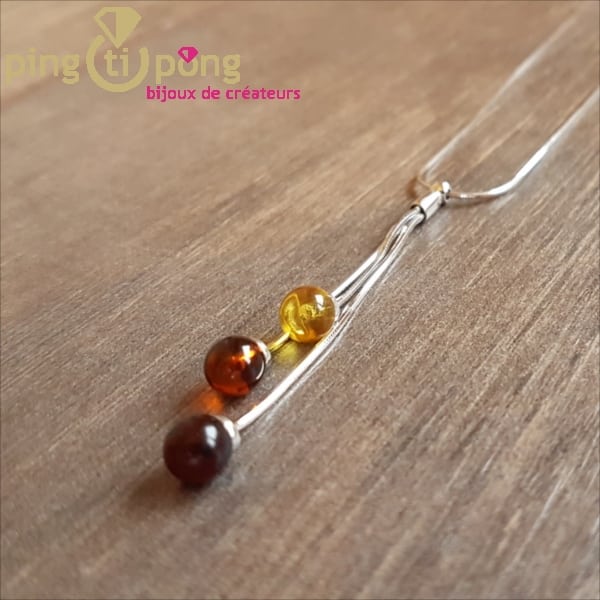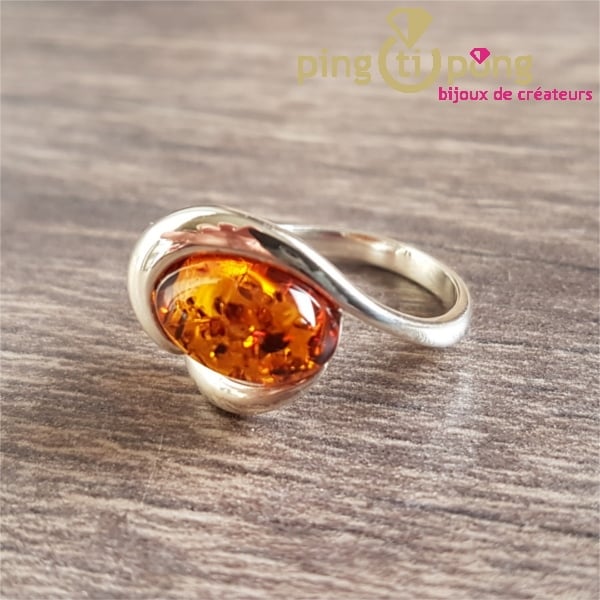The history of amber, a material that has fascinated humans for hundreds of years…
Here we will tell you a little part of the history of amber, this amazing material that is used to make amber jewellery. Hundreds of years ago, people were fascinated by the extraordinary and inexplicable properties of golden pebbles found on coasts and in coastal forests. These stones would burn if thrown into the fire, giving off a pleasant pine scent and aromatic smoke. Another magic, when you rubbed these stones, they could attract other small objects.
The inside of these stones seemed to hide small plants or insects that seemed to have found their way in also by magic.
This was enough to arouse the curiosity of primitive man, with admiration and respect for this precious and unusual stone. No wonder man has begun to attribute magical powers to amber.
Excerpt from the amber ledger of Elzbieta Mierzwinska
 large piece of amber before cutting and polishing for the manufacture of a piece of jewellery
large piece of amber before cutting and polishing for the manufacture of a piece of jewellery
A brief history of Baltic amber
Amber is one of the few substances on earth that we consider a precious stone and is not of mineral origin. Diamonds, jet (both from coal) and amber are the only precious stones or gemstones of plant origin. The value of any gemstone is directly related to its rarity. Like diamonds, amber is the result of nature’s action over thousands of years. This is one more reason to use it to make beautiful jewellery.
 Set of cut and uncut gemstones : Diamond, amber, ruby, emerald, topaz, jet, sapphire…
Set of cut and uncut gemstones : Diamond, amber, ruby, emerald, topaz, jet, sapphire…

Amber touches the soul, enchants the eye, warms the heart and excites the imagination of the scientific world. Amber, an organic plastic, has the unique and singular ability to encapsulate and preserve the organic matter it encounters, like the fly trapped in honey. Baltic amber is approximately 40-60 million years old and has been considered a gemstone by many ancient cultures, prized for its protective as well as decorative qualities.
Not long ago, in the West, the film Jurassic Park caused a strong interest in this gemstone. However, amber has long ruled human hearts and minds – in fact, amber has even been a key value for entire economies.
Within matter, amber has enclosed plants and insects and their DNA molecules – the basic code of life. That’s why amber is often referred to as “a window to the past.”
 Baltic amber with a trapped insect, here a scorpion
Baltic amber with a trapped insect, here a scorpion
The most common inclusions are pieces of plants, oak leaf remains, pollen, spores, leaves, twigs, but most of all the most common inclusions are the most well-known of all – insects. At least 214 plant species have been identified by morphological analysis of amber. The scientific study of amber has provided a wealth of valuable data on the ancient world, scientific data that would have been lost forever without the conservation quality of amber.
“I’m picking up a piece of Baltic amber because of its natural beauty and its connection to the living world. Not having a scientific opinion, I have no idea of the proper name of this tiny creature inside, of these creatures I should say – for they are many.
I know it’s charming and I hope to find it in a piece of jewelry I’ll have made one day. The piece of amber is in my private collection. It’s really beautiful to hold in the palm of your hand a reflection of the world as it was before the first man was born. “
“Andzia”, book bought in Gdansk, Poland, in the mid-90s.
At the origins of the Baltic Amber story
About 45 million years ago, the territory of northern and central Europe now known as Finnoscandia was covered by a thick “amber forest” stretching from the Norwegian coast to the Caspian Sea before the continental block separated to form what we know as today’s Europe.
Amber is not, as is generally thought, pine sap, but amber is derived from the fossilization of plant resins due to injury or radical climate change. Specialists have recently put forward three species of trees close to those that produced these resins. These are:
 The amber resulting from complex chemical transformations of the resin has been transported to the Baltic Sea by waterways
The amber resulting from complex chemical transformations of the resin has been transported to the Baltic Sea by waterways
~ Agathis (aurakaria, Australia)
~ Cedrus atlantis (cedar, Atlas, North Africa)
~ Pseudolarix wheri (larch, Canada)
Scientists at the Polish Science Museum speculate about the reddish hues found in cherry amber, they think it is due to resin from deciduous trees, such as plum or cherry trees.
The common name used for these amber trees is Pinus Succinifera. It is assumed that during the climate change, they produced an abnormally large resin secretion. This resin has undergone countless physical and chemical changes over thousands of years, eventually resulting in amber (succinite). Amber resins were first carried to the sea by the freshwater rivers of the mountainous regions of the amber forest, even entire trunks that were badly damaged by temperature fluctuations were transported to the sea.
 Resin falling from a tree, it is the original component of amber.
Resin falling from a tree, it is the original component of amber.
It is known that the inclusions present in the amber of the subtropical forest also contained the following tree species: palms, cypresses, magnolias, rhododendrons, tea bushes, oaks, maples, horse chestnuts, mistletoe and cinnamon trees as well as various kinds of heather, mosses, lichens and moulds. This forest must have been incredibly beautiful. For scientists, the Pinus Succinifera was a tree similar to today’s redwoods. “Succinum” is the Latin name for resin or sap, also meaning juice – later it came to mean amber.
The quality of amber is assessed by the density of succinite contained in the amber. Baltic amber contains the highest proportion of succinite acid, making Baltic amber the most valuable quality of amber.
The Amber Road
The ancient trade routes of amber brought nations far apart into contact with each other. Since it is a luxury product found only in rare and widely scattered geographical areas, amber was one of the few products worthy of being transported over such distances. From the Baltic Sea to the Elbe River along the Danube, the ancient trade routes of amber can be traced.
Amber was one of the earliest commercial products and was traded for centuries. Amber pendants have been found dating back to the Palaeolithic era (12000 BC). Archaeologists have discovered the remains of amber jeweller’s workshops dating from the Neolithic period. At the same time amber caches were also found, embedded underneath the foundations of the houses, probably to bring good luck to the occupants.
 Cliffs, amber has been transported from sea to sea by rivers since prehistoric times.
Cliffs, amber has been transported from sea to sea by rivers since prehistoric times.
The ancient amber route first passed through the North and by water from Jutland to the Elbe, from West Pomerania to the Oder, through Bohemia, through Pomerania to the Vistula and from the Samland Peninsula to the Black Sea coast. Then overland, over the Brenner Pass to Italy, to the heart of the Roman Empire.
During the period from the 1st to the 4th century B.C., it was the Celts who re-established very ancient trade routes, which had existed long before them, previously dominated by other peoples, especially the Phoenicians. Amber artefacts from various periods have been found in the tombs of Mycenae in Greece as well as in Babylonia and Egypt in the tomb of Tutankhamun and even in Brighton in the United Kingdom where a particularly famous amber cup was found in a burial mound.
By the 1st century AD, Rome was becoming the undisputed centre of the amber industry.
 Gladiatorial combat, amber was widely used in Roman arenas
Gladiatorial combat, amber was widely used in Roman arenas
The Romans used amber in a number of different objects, including currency. They apparently held amber in higher esteem than the blond-haired Baltic slaves, the amber harvesters, whom they brought back to Rome with the amber. Amber was mentioned by Homer in the Odyssey and it was written by Pliny the Elder that the price of a small piece of amber sculpture was worth more than a healthy slave.
We learn from the Great Book of Amber that in Nero’s time, an expedition was sent to the Baltic Coast to obtain amber. He brought back such a quantity that the gladiators’ battle scenes were engraved exclusively on amber. Even the net used to restrain wild animals and cover the podium had a piece of amber in every knot. ‘
-Pliny, Natural Stories, XXXVII
The Middle Ages were a period of great social unrest and migration. Prior to the 1100s, Gdansk served as the main production centre for amber. The introduction of Christianity led to the popularization of the use of the cross as a motif for amber objects.
After the Teutonic Knights returned from the Crusades, in the second half of the 12th century AD, they became the undisputed masters of Prussia, of the amber reserves of the Baltic, and of the manufacture of amber objects – mostly religious objects such as paternoster beads (Christian rosaries).
These Knights ruled with an iron fist. A person caught in possession of a piece of amber that was not part of a rosary was severely punished and often hanged. Lithographs usually depict the amber fisherman painted with the gallows, a sinister warning to anyone attempting to appropriate amber outside the church.
On my first trip through Poland, I saw for the first time through the train window one of the great castles of the Teutonic Knights: Marlbork Castle. I thought I was dreaming … seeing these walls, these courtyards, these moats, these turrets with these banners floating in the wind …
I was lucky enough to return to Malbork Castle a few years later. The collection of amber objects has over 2,000 catalogued pieces and is eclectic – ranging from antique pieces made by early man to the contemporary work of craftsmen who work with amber today.
 Marlbork Castle, castle of the Teutonic knights masters of amber in the Middle Ages
Marlbork Castle, castle of the Teutonic knights masters of amber in the Middle Ages
Amber still crosses the seas today, and has been exported to China for thousands of years. The Chinese use it, among other things, in Chinese medicine to fight infections, soothe nerves etc… while in Western countries it is mainly used in jewelry to make amber jewelry. Its warm colour goes particularly well with the colour of cold silver. But it is also used for its scent by making it burn.

Also read :


